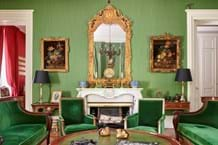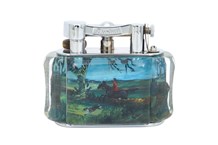Some of the problem with run-of-the-mill silver entries such as Victorian four-piece tea services and assorted flatware, is that in today’s world people just don’t use these pieces anymore and they now want pieces that are both decorative and useful. Conversely novelty, provincial and early 18th century silver all remains sought after, a fact which was illustrated in Hamptons’ April 16-17 sale of a George I silver coffee pot.
The pot was assayed in London in 1716 and bore the mark of Thomas Holland. Where most pots from this period are conical in shape, this one was set apart by its octagonal tapering straight sided form. Standing at 11in (27.5cm) high and weighing 31oz, it had a domed hinged cover and cast swan neck spout along with armorials dating from c.1745. Carrying hopes of £6000-8000, the pot attracted more private than trade interest, eventually getting away to a local private buyer at £11,500.
Silver found further success with a 107-piece set of flatware by Jean E. Puiforcat for Cartier. Auctioneer Julia Walker described the set as “rather a mixed bag”, given its unequal combination of utensils. The stylish but plain design of the set, which had been stored for years in the private vendor’s garage, appealed to the market and they got away at £5500 against top hopes of £4000.
Hamptons hold these fine sales four times a years and each sale focuses on different areas. This April sale contained no furniture, instead placing a strong emphasis on silver, ceramics and glass, which was on the whole well received. “I think the market held up really well, particularly given that the sale was held just a week before Easter,” explained Julia Walker. A pair of still life painted porcelain plaques by Le Bel topped the ceramics. Each framed 10 by 13in (26 x 32.5cm) plaque was rectangular in shape and painted with flowers and fruit on top of a marble plinth which was inscribed Le Bel 1805, Manuefre de Mr Lefebure Rue Amelot a Paris. Ms Walker admits the £800-1200 estimate was a bit low considering the quality of the pair but their success is proof that “quality will always out even in a difficult market”. The pair eventually got away to one of the many private buyers at the sale at £5500.
Over the years car mascots have been used not merely to advertise the marque of the machine but also as good luck charms and were patriotic symbols during the First World War. Ever since they were banned in the 1960s after fears of potential injury during car accidents, their collectability and value has steadily increased, with some of the most popular mascots being those made by René Lalique. The example offered at Hamptons had been made by Lalique c.1928 and was named Chrysis after the Greek mythological lover of Agamemnon and is also known as Vitesse, modelled as a personification of speed, kneeling with her hair streaming out behind her. At 5 1/2in (14cm) high, the mascot attracted lots of interest via the Internet and, against an estimate of £1000-1500, it sold at £4000 to a private collector.
Aside from a section of Parian ware which saw limited interest, ceramics were strong, with the best money taken by a small Royal Doulton figure Harlequinade Masked HN 1341. The 8in (21cm) high figure had been restored but it held particular appeal to American buyers and sold on the telephone at £3000.
Considering its dreadful condition, the success of a c.1900 Royal Worcester twin-handled pot pourri vase and cover came as a shock. The 9 1/4in (23.5cm) high vase had been painted with swans in flight against a duck egg blue ground by the famous Royal Worcester designer Charles Baldwin. However, a great deal of the paint detail had worn away and the knop was missing. Given a £300-500 estimate to reflect the dubious condition, the trade remained keen and took the vase to a winning £2400.
The restoration to one of a pair of Wedgwood fairyland lustre vases was described by Julia Walker as “very amateurish”; however, the trade still wanted them. Each 8in (20.5cm) high vase was of shouldered ovoid form and painted in very bright colours with elves, fairies and a bridge. Carrying hopes of up to £600, the pair got away at £1550.
The doll market is another that has been in depression of late so Julia Walker was thrilled with the success of a Jules Steiner Bébé doll. The ball body of the French doll bore the printed mark Le Petit Parisian Bébé Steiner but it is, of course, the head of antique dolls which hold the most importance to collectors. In this case the doll had a closed mouth, fixed blue glass eyes and pierced ears. This particular model was fairly rare and in good condition bar a few paint flakes and wear to the body and the fact that the doll’s hair had been severely chopped by an over-enthusiastic young hair stylist. Despite this it got away to a private buyer at a mid-estimate £1700.
Proof that some silver does do well
WHILST it is widely acknowledged that the antiques trade is currently suffering a significant downturn, the silver market has been in the doldrums for much longer.




